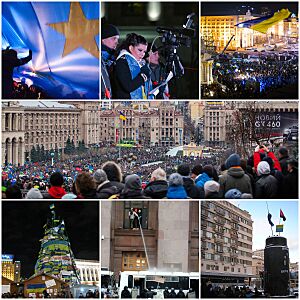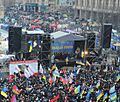Euromaidan facts for kids

Euromaidan (/ˌjʊərəmaɪˈdɑːn, ˌjʊəroʊ-/ YOOR-oh-MY-dahn; Ukrainian: Євромайдан, romanized: Yevromaidan, IPA: [ˌjɛu̯romɐjˈdɑn], lit. Euro Square), or the Maidan Uprising, was a wave of demonstrations and civil unrest in Ukraine, which began on 21 November 2013 with large protests in Maidan Nezalezhnosti (Independence Square) in Kyiv. The protests were sparked by President Viktor Yanukovych's sudden decision not to sign the European Union–Ukraine Association Agreement, instead choosing closer ties to Russia and the Eurasian Economic Union. Ukraine's parliament had overwhelmingly approved of finalizing the Agreement with the EU, but Russia had put pressure on Ukraine to reject it. The scope of the protests widened, with calls for the resignation of Yanukovych and the Azarov government. Protesters opposed what they saw as widespread government corruption, abuse of power, human rights violations, and the influence of oligarchs. Transparency International named Yanukovych as the top example of corruption in the world. The violent dispersal of protesters on 30 November caused further anger. Euromaidan was the largest democratic mass movement in Europe since 1989 and led to the 2014 Revolution of Dignity.
During the uprising, Independence Square (Maidan) in Kyiv was a huge protest camp occupied by thousands of protesters and protected by makeshift barricades. It had kitchens, first aid posts and broadcasting facilities, as well as stages for speeches, lectures, debates and performances. It was guarded by 'Maidan Self-Defense' units made up of volunteers in improvised uniform and helmets, carrying shields and armed with sticks, stones and petrol bombs. Protests were also held in many other parts of Ukraine. In Kyiv, there were clashes with police on 1 December; and police assaulted the camp on 11 December. Protests increased from mid-January, in response to the government introducing draconian anti-protest laws. There were deadly clashes on Hrushevsky Street on 19–22 January. Protesters then occupied government buildings in many regions of Ukraine. The uprising climaxed on 18–20 February, when fierce fighting in Kyiv between Maidan activists and police resulted in the deaths of almost 100 protesters and 13 police.
As a result, Yanukovych and the parliamentary opposition signed an agreement on 21 February to bring about an interim unity government, constitutional reforms and early elections. Police abandoned central Kyiv that afternoon, then Yanukovych and other government ministers fled the city that evening. The next day, parliament removed Yanukovych from office and installed an interim government.
Images for kids
-
Protesters in Kyiv, 29 December 2013
-
Opposition leaders Vitali Klitschko, Arseniy Yatsenyuk and Oleh Tyahnybok, addressing demonstrators, 27 November 2013
-
The largest pro-European Union protests outside Kyiv took place at the Taras Shevchenko monument in Lviv
-
Euromaidan in Munich
-
Self-defense of the Maidan
-
Petro Poroshenko addresses Euromaidan on 8 December 2013
-
Headquarters of the Euromaidan. At the front entrance there is a portrait of Stepan Bandera, a twentieth century Ukrainian nationalist.
See also
- Cold War II















